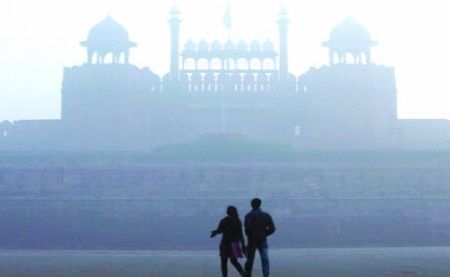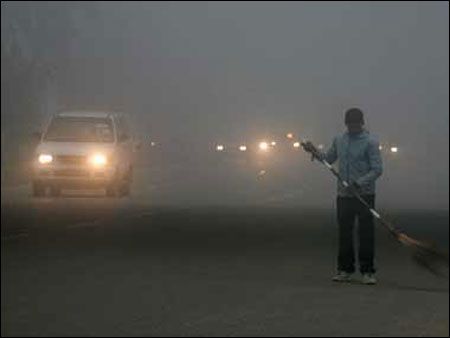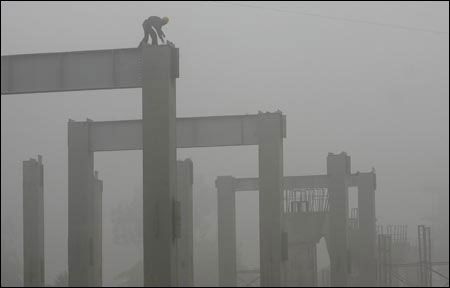13 out of the world's 20 most polluted cities are in India.
Most shockingly, the latest Central Pollution Control Board statistics reveal that the pollution levels in Gwalior, Raipur and even little known Kashipur are higher than that of Delhi which means we have some of the most polluted zones in the world.
'Half of the 252 cities in India have already crossed critically polluted levels. The government must declare a national emergency on air pollution and treat this on a war footing.'
Rashme Sehgal reports for Rediff.com
 The United States decision to monitor air quality levels in Delhi and other Indian cities has sent shock waves in the ministry of environment and forests.
The United States decision to monitor air quality levels in Delhi and other Indian cities has sent shock waves in the ministry of environment and forests.
Union Minister for the Environment Prakash Javadekar refuses to comment on this US announcement, but there is no doubt that this has come as a major embarrassment.
The US mission has been monitoring air quality in Beijing and for several years, the Chinese capital was dubbed the most polluted city in the world followed by Shanghai.
Delhi now enjoys this distinction with 20 million Delhites having to inhale dangerous airborne particles known as PM2.5 while going out to do their shopping, taking a walk or simply driving to their place of work.
These small particles, which are less than 2.5 micrometres in diameter, get embedded in the lungs and are known to cause lung cancer and heart disease.
Delhi's air has been found to have PM2.5 concentrations of 153 micrograms and PM10 concentrations of 286 micrograms -- four times permissible limits.
The World Health Organisation has issued regular warnings to the Indian government about rising particulate levels.
What has been a greater source of concern for WHO officials has been the fact, pointed out in its 2014 study on air pollution, that 13 out of the world's 20 most polluted cities are in India.
These include Delhi, Patna, Gwalior, Raipur, Ahmedabad, Lucknow, Firozabad, Kanpur, Amritsar, Ludhiana, Allahabad, Agra and Khanna.
Most shockingly, the latest Central Pollution Control Board statistics reveal that the pollution levels in Gwalior and Raipur are higher than that of Delhi which means we have some of the most polluted zones in the world.
Beijing and Shanghai's thick smog saw schools and offices being closed down and its municipality taking strict measures including taking cars off the roads in order to ensure pollution levels came down. No such strict action has been taken by the Indian State.
 Javadekar recently launched a new National Air Quality Index, AQI, to indicate the quality of air in a city and its impact on health.
Javadekar recently launched a new National Air Quality Index, AQI, to indicate the quality of air in a city and its impact on health.
Said Javadekar, 'We realise the situation is very serious. The government will not allow a business as usual scenario,' adding that the AQI, was a 'One Number-One Colour-One Description' for people to judge air quality.
In the initial phase the monitoring of AQI will take place in 46 cities with a million plus population and 20 state capitals.
Later, it will be expanded to another 200 cities with categories being divided into Good, Satisfactory, Moderately Polluted, Poor, Very Poor, and Severe.
Dr Mukesh Sharma from the Indian Institute of Technology-Kanpur, who helped created the AQI, emphasises this is the first time India will have its own index across cities. But health experts question how far state governments and local municipalities are empowered to bring down pollution levels.

"Half of the 252 cities in India have already crossed critically polluted levels," warns Anumita Roychowdhary, deputy director general, Centre for Science and Environment.
"The government must declare a national emergency on air pollution and treat this on a war footing," she says
"India is not the only country who needs to take tough measures," she adds. "It is being done across the globe. Very recently, the municipality of Paris refused to allow outside diesel vehicles to enter the city. They have also shut down factories in the city in order to reduce pollution levels."
The situation in India's capital has become so dire that the American embassy presently issues daily smog warnings to inform its diplomats and staff about the toxic air as they do in Beijing and Shanghai.
US officials confirm that they plan to extend the AirNow US missions to other cities across the globe.
Air pollution has jumped to the number five spot amongst the top killers according to India-specific data released by the Global Burden of Disease which has stated that it caused over 600,000 deaths and a loss of 17.7 million health years of life in 2010.
Worldwide, outdoor air pollution caused 3.2 million premature deaths and over 74 million years of healthy life lost in 2010.
Dr Vinod Raina, who heads the oncology department at Fortis hospital, notes that during his three decade-long tenure at the All India Institute of Medical Sciences, "We were getting 10 lakh (1 million) new cancer cases every year out of which approximately one lakh (100,000) were lung cancers cases"
"We have to quantify how many of these lung cancer cases are pollution-related, but the indicators are there," adds Dr Raina.
The seriousness of the problem can be best understood if we look at the PM2.5 levels of Gwalior, Patna and Raipur which have reported 144, 149 and 134 levels respectively. By comparison, London has an annual PM2.5 reading of 16.
WHO's 2014 study looked at 1,600 cities across 91 countries and showed Delhi had the world's dirtiest air.
Officials at the Indian Meteorological Department remain in denial, insisting that atmospheric dust which blows in from Rajasthan, Punjab and Haryana is responsible for this pollution and that yearly averages in the last four years show that the air quality of Delhi remains better than that of Beijing.
Officials in the green ministry also insist, unlike China, they do not hide data and if the debate around air pollution has intensified, it is because the government has been so upfront with its data.
"Delhi's air quality is better than Beijing in summer and much better in the monsoon season," says Dr Gulshan Beig, an air forecaster at the Indian Meteorological Department. "It is winter pollution in Delhi and the sudden spikes in pollution levels that are quite high."
Even with an annual average PM2.5 reading of 110 to 120, Delhi would still be among the world's most polluted cities, if not the worst.
Studies undertaken by Yale University in 2013 and also a World Bank report released last year that surveyed 132 countries ranked India 126th for environmental performance.
Dr Sundeep Salvi, a pulmonologist and director of the Chest Research Foundation in Pune, who has been studying lung functions across rural and urban India, blames the heavy increase of vehicular traffic for plunging health levels.
In 1951, India had three million vehicles. By 1997, the number had gone up to 37.2 million. In 2012, it had increased to 100 million motor vehicles, he points out.
"Vehicular emissions are responsible for 50% of Delhi's air toxicity," Dr Salvi adds.
The government needs to act swiftly or else it will not be able to cope with this major health epidemic set to overtake the country.











 © 2025
© 2025